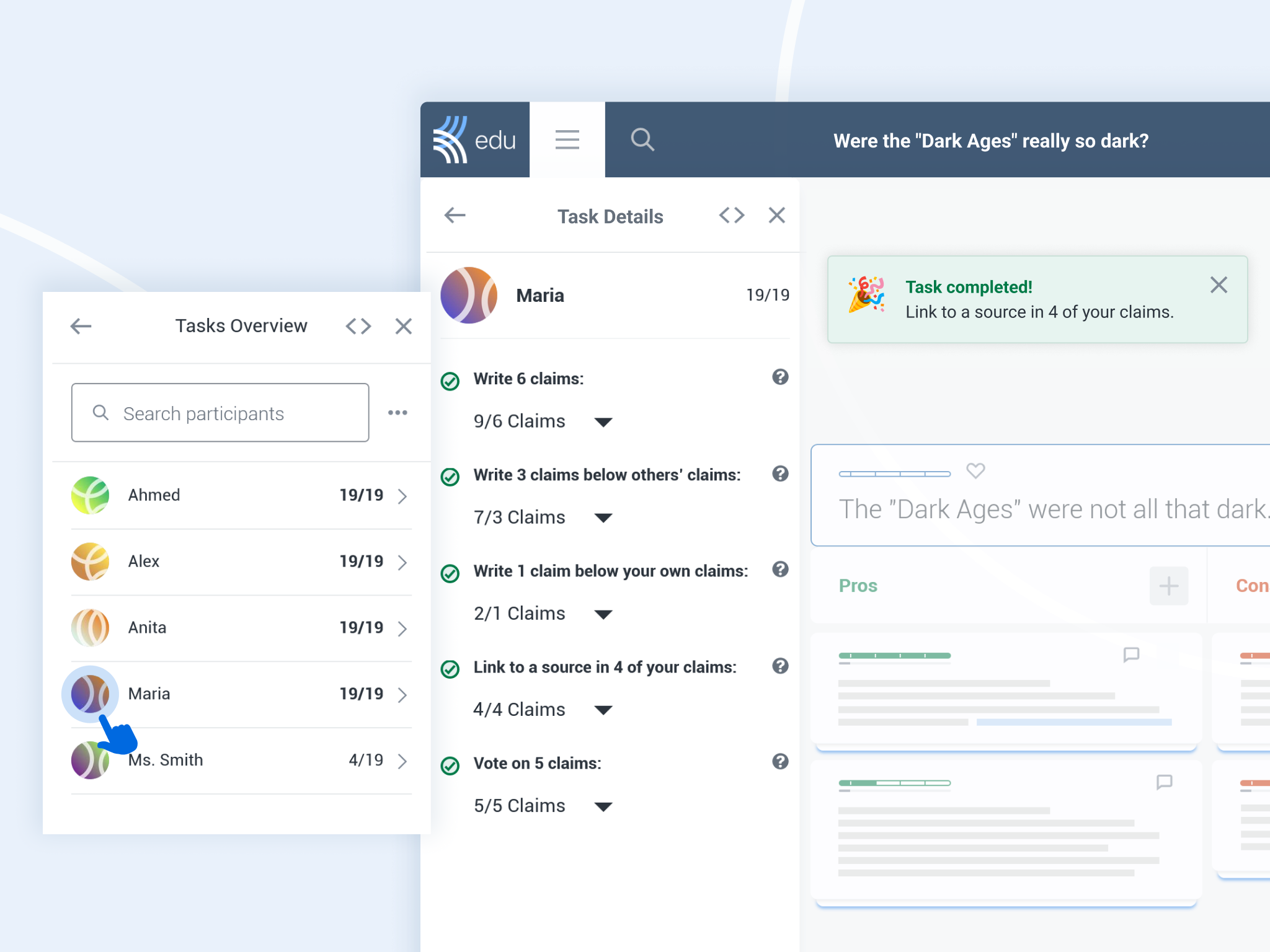The word motivation is derived from the Latin “movere,” literally meaning “to move.” Motivation is crucial for students to move towards achieving their goals, yet many students struggle to stay motivated in their studies and job searches. As educators, how can we make sure that we set students up for success?
If it feels like the only thing motivating your students is the bell that signals the end of the school day, it’s time to unleash the power of interactive and engaging Kialo Edu discussions — all for free! Students can actively participate and collaborate in discussions while building their confidence and topic comprehension. Here are eight of our favorite activities to motivate students.
1. Use icebreaker discussions to motivate students
Icebreakers have stood the test of time for a reason — they are a great and easy to set up motivational warm-up activity! They don’t require in-depth knowledge, so are therefore more inclusive and less intimidating for students. Moreover, they reveal information about students, allowing educators to increase motivation by personalizing learning.
Icebreakers can help students enjoy and be more comfortable with class discussions, generating motivation that can be applied to other activities. For inspiration, check out Kialo Edu’s collection of ready-to-use icebreakers that feature low-stakes, easy topics for all ages. These can range from discussing if playing video games benefit learning to if it would be good to be famous, so you’re bound to find something for your students to stake their opinions on!
2. Use role play in discussions to motivate students
A lack of confidence in sharing opinions can be confused with a lack of motivation, as students may feel shy in sharing their own opinions on a certain topic. However, asking students to contribute to discussions through role-play can help build confidence through fun engagement.
For example, when discussing whether ancient Athens or Sparta was the best place to live, your classroom could be filled with Spartan soldiers, Athenian intellectuals, and women from both city-states.
Another example is to have students portray different factions in the French Revolution in discussing if the French Revolution needed to be so bloody. Students can make first-person contributions in role, developing a deeper understanding of the topic.
3. Use time-limited discussions to motivate students
Having no endpoint can demotivate the best of us! Combat this with time-limited discussions to focus students’ minds on the end goal, and encourage them to plan ahead. In Kialo discussions, you can start and stop a discussion manually, or set a specific time and date to limit student contributions.
These types of discussions are particularly motivating for those students who believe they have all the time in the world to complete an activity. This can be particularly useful when using Kialo discussion as assessments, such as in literature units exploring questions like, “Does Lord of the Flies present an accurate picture of human nature?” or “Is Lady Macbeth more villainous than Macbeth himself?“
4. Give goal-oriented tasks to motivate students

To motivate students to engage with the discussions, you can set Tasks in Kialo discussions to give students motivational measurable goals. You could specify how many claims to write, sources to link to, or claims to vote on.
Moreover, giving feedback directly to students during live discussions can elevate motivation levels further!
5. Use a Debate Taboo game to motivate students
Offering students a sufficient level of challenge is high on the list of motivation tactics, so why not try a game of Debate Taboo? Challenge students to expand their vocabulary in discussions by providing a list of taboo, or banned, words.
You could aim to encourage more advanced historical terminology, a greater range of conjunctions, or more powerful adjectives — tailor it according to your lesson objective and focus. For ESL students, this can be useful to practice vocabulary on common discussion topics, such as living in the countryside vs. the city, a classic desert island survival scenario, or whether a beach vacation better than one in the mountains!
To extend the activity, ask students to select the winners by voting for the claims with the most expansive vocabulary.
6. Use quizzes to motivate students
Showing off knowledge in a quiz isn’t just motivating — retrieval practice is also proven to help students retain knowledge. Prepare students for quizzes by challenging them to use Kialo Edu to build in-depth topic maps during sessions.
Knowing that they will be quizzed on the content makes research purposeful and encourages students to delve deeper into topics. Deciding whether students can refer to their topic maps during quizzes is an ideal way to differentiate too!
7. Use a Tug of War discussion to motivate students

Give students the chance to flex their cerebral muscles in a collaborative Tug of War discussion. One team “pulls” first by writing a pro linked to a starter claim. The other team then “pulls back” with a linked con. This continues down the branch until one team cannot complete their pro or con — they are overpowered and the other team is the winner! They can then repeat the game for each starter claim.
For those students who lack motivation and normally do “just enough” to complete a task, this activity will encourage them to delve deeply into their knowledge to win the battle. And to emphasize quality over quantity, educators can make use of our handy grading feature, setting a minimum grade for a claim to be valid.
8. Use a discussion relay to motivate students
Sometimes students’ lack of motivation comes from sitting still in a classroom all day, so try a discussion relay to exercise brains and bodies! Set up the Kialo discussion on devices at one end of a large space and student relay teams at the other. Allocate each team a different starter claim to collaboratively build out.
The first student should race to read the thesis and their starter claim and report back to their team, who discuss the first pro or con they would like to add. The next student races to add the claim to the discussion, whilst the rest of the team discusses the next contribution.
The race continues until a team has added a specified number of claims, which could be differentiated for each team. The winners could be the first team to hit their target, or, to ensure students write quality claims, teams could vote on each other’s contributions.
Aside from being great for motivating students, these activities share another winning feature — they require little preparation! Most can be set up with just a few clicks, meaning you can spend more time facilitating and providing support during the discussions.
We would love to hear how you use these eight activities to (wait for it!) motiv-8 your students! Contact us at feedback@kialo-edu.com, or on social media with your winning tactics.

